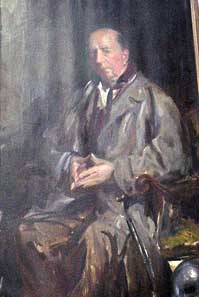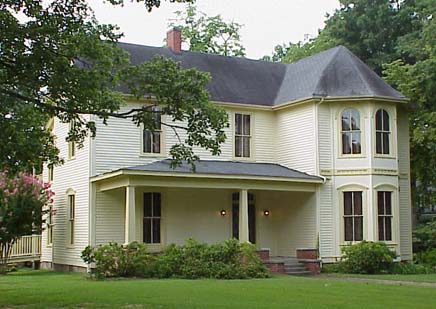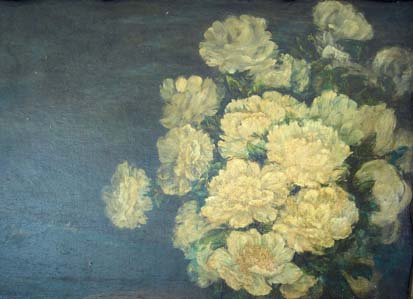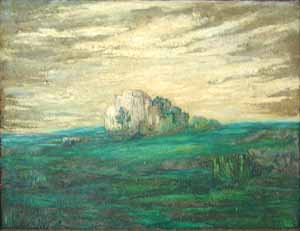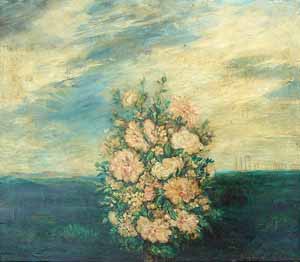Major Works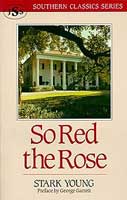
Plays
- Two Plays for Children, 1926
- Theatre Practice, 1926
- Sweet Times and Blue Policeman (1925)
- The Saint (play), 1925
- The Colonnade (play), 1924
- The Three Fountains (sketches), 1924
- The Flower in Drama, 1923
- Three Plays, 1919
- Addio, Madretto, and Other Plays, 1912
- Six One-Act Plays, 1911
- Guenevere (verse play), 1906
Poetry
- The Blind Man at the Window (poems), 1906
Essays
- Glamour (essay), 1926
- Encaustics (1926)
Novels and Nonfiction
- The Pavilion: Of People and Times Remembered, of Stories and Places (autobiography), 1951
- Immortal Shadows (dramatic criticism), 1948
- A Southern Treasury of Life and Literature (ed.), 1937;
- So Red the Rose (1934)
- River House (1929)
- The Theatre (1927)
- The Torches Flare (1927)
- Heaven Trees (1926)
Translations
- Best Plays by Chekhov: The Sea Gull, Uncle Vanya, The Three Sisters, The Cherry Orchard, 1956, translated
- tr. Mandragola (play), 1927
Short Stories
- Feliciana (1935)
- The Street of the Islands (1930)
Stark Young: A Biography
by Rachel Hicks (SHS), updated by N. Jacobs
Stark Young was born in Como, Mississippi, on October 11, 1881, to parents Mary Clark Starks and Alfred Alexander Young. His mother was the daughter of Caroline Charlotte McGehee (pronounced McGee) and Stephen Gilbert Starks (Pilkington 484). The McGehee family of his maternal grandmother was a very old Southern line and developed great importance to Young as he grew (Maritine 201). According to Pilkington, the McGehee heritage is prevalent in most of his novels as well as the traditions and life the family taught him (484).
Young’s father was a Civil War veteran and worked as doctor in his town of Como. In 1890, after the birth of his younger sister Julia (Pilkington 485), his mother died (Maritine 201). At that time, the children were separated from their father and sent to live with Hugh McGehee, an uncle (Pilkington 485). Then, in 1895, when Young was fourteen, Alfred Young re-married and moved the family to Oxford, Mississippi. Young entered the University of Mississippi when he was only fourteen.
That same year, the Young family took a trip to Chicago and visited the Chicago Art Institute. Afterward Young asked his father if he could take painting classes. His father refused (Maritine 201). In American Novelists, James J. Maritine quotes a passage Young related much later in his autobiography The Pavilion: “Only after years did I realize that in our social scheme, as with country families in England from whom we drew our standards, your son could be a planter, a lawyer, a judge, a senator or a doctor–in sum, a man–but a musician, a painter, a poet were likely to be effeminate, weaklings, certainly no credit to our class. …Such is the way it was, and, whatever its rewards may be, every social system has its price.” This ideology is a theme in several of Young’s works.
At the University of Mississippi (at the young age of fourteen), Stark Young joined a fraternity and edited the school’s annual. He finally graduated with a B.A. in 1901 at twenty years of age (Haycraft and Kunitz 1566). From there, he transferred to Columbia University in New York City with funding from two aunts (Maritine 201). He chose Columbia because it was considered to have the best English department in the country. He was highly influenced by one of his teachers, Brander Matthews, who was then America’s leading theatre critic (Pilkington 485). In 1902, Young received his M.A. in English (Maritine 201). After graduation he began a career as a newspaper reporter but soon decided to leave New York in favor of the North Carolina mountains (Pilkington 485). During the winter of 1902, he wrote poetry and read great works of literature. In 1903, he accepted a position at Water Valley, a military academy on the outskirts of Oxford so that he could be in close proximity to his father (Maritine 201). In April of 1904, Water Valley closed, so Young joined the English department at the University of Mississippi where he stayed until 1907, when he took a job at the University of Texas (Abbott 785). While at the University of Mississippi, he published his first two works The Blind Man at the Window, a poetry book (some of which he wrote in the mountains in 1902), and Guenevere, a play. Once at Texas, he remained until 1915. While at Texas, Stark Young began the Curtain Club (a drama association for which he wrote Addio, Madretto and Other Plays) and began the Texas Review (a journal now edited by Mississippian Paul Ruffin). From 1915 to 1921, Young taught at Amherst College in Massachusetts (Abbott 785). At Amherst, he wrote for the New Republic, Nation,North American Review, and Yale Review. He took a year off from teaching in 1919 to live and write in Spain and Italy. Already he was contributing to the Bookman, the Dial, and Theatre Arts Magazine in which At the Shrine was printed (Pilkington 485). During his sixteen years of teaching, Young was highly popular among his students (Maritine 201).
When he was forty,Young decided to move to New York and break into the field of free-lance writing (Haycraft and Kunitz 1566). He joined the staff and editorial board at the New Republic in 1921 and remained in 1924 (Abbott 785). He also became the associate editor of Theatre Arts Magazine during this time and had his “The Queen of Sheba” printed in it. In 1923, The Flower in Drama was published by Charles Scribner’s Sons. Also during this year he directed The Failures, a play by Henri Lenormand, for the Theatre Guild. The following year, the Greenwich Village Theatre presented a production of his play The Saint. The same year (1924) Scribner’s Sons published a volume of Young’s drawings entitled The Three Fountains. In 1925The Colonnade was performed by the London Stage Society in London, England (Pilkington 486). In addition to this, from 1924 to 1925 he worked as a dramatic critic for the New
York Times. He soon rejoined the editorial staff at the New Republic where he stayed until 1947. In the two years following his work at the Times, both Theatre Practice
The Walton-Young home on the campus of Ole Miss.
and The Theatre were published. These books are now used as authorities in theatre schools across the country (Pilkington 486). Throughout the 1920’s and 1930’s, Young wrote what John Pilkington expressed as “the best drama criticism since Coleridge and Hazlitt” (486). His most critically-acclaimed novel, So Red the Rose, was published in 1934. It was also made into a movie. He also translated several works during this time including some works by Chekov. His translations are still the most widely used today (Abbott 785). The 1940’s brought some changes, and Young retired. (Maritine 204).
While in retirement Young began serious painting. He had occasionally painted landscapes and flowers before, but in 1943 his new work received a one man show under the sponsorship of the Friends of Greece. Reporting the event,Time called Stark Young
“a discerning critic of art and the theater (in the New Republic and elsewhere) for some 20 years. Stark Young is known also as a best-selling novelist (So Red The Rose), a poet, a playwright, a translator of plays and a lecturer. Last week he made a firm bid to be known as a painter, gave his first exhibition at Manhattan’s Friends of Greece, Inc.”…In Italy, which he has visited about 18 times, he used to “go to the galleries the moment the doors opened and stay there all day.” If his painting matches the quality of his dramatic criticism, it will be something.”
In 1945 the Rehn Galleries held an exhibit devoted to his work. According to Pilkington, both exhibits received enthusiastic reviews from New York art critics.
Photos of the three Stark Young paintings above (from the collection of Ronda Keane) courtesy of Marlene Snyder
Young was friends with many famous people of the time, including the playwright Edward Sheldon and the actress Doris Keane. His autobiography, The Pavilion, was published in 1951. In the 1950’s Stark Young made many trips to Greece and Italy (18 times according to Time), many with his longtime roommate William M. Bowman. He also often visited his sister during the summers in Austin, Texas.
In May 1959, Stark Young suffered a stroke. He did partially recover, but his activities were severely curtailed. Stark Young died a bachelor on January 6, 1963, in a New York nursing home (Maritine 204) one week after his sister died. Bowman took the body back to Mississippi where Young was buried in Friendship Cemetery, Como, Mississippi.
Reviews
A Review of So Red the Rose
by Rachel Hicks (SHS)
Often considered Stark Young’s best and most influential novel, So Red the Rose, published in 1934, was the fourth of five novels. Unlike his earlier works, this novel was set in the southern part of Mississippi near Natchez, and its time frame spanned from 1860 to 1865. The action in the story primarily takes place on the two plantations of Montrose, owned by Hugh McGehee (pronounced McGee), and Portobello, owned by Malcolm Bedford.
The plot itself, while interesting, is not the focus of the novel; and for that matter, neither is the time frame of the Civil War. When Stark Young wrote this book, he intended it to be more of a tapestry of a way of life rather than a romantic war novel. He intended to show the continual struggle of the agrarian South and the industrial North as well as the search for a balance between tradition and a century old culture and the changing times. He presents his case for the value of the South’s agrarian lifestyle through varying perspectives. His large, although sometimes cumbersome, cast of characters allows that. One very unique aspect of Young’s novel is the use of cameos by historical figures such as Jefferson Davis, William Tecumseh Sherman, and Ulysses Grant. By incorporating these people into his fictitious novel, he is given some dramatic license to show us an alternate view of these figures. It also gives the reader a fuller picture of the Civil War and leads to a fresh perspective the reader might not have had otherwise. The mood at the end of the novel is quite different from the light, careless air that it opens with. With devastation rampant and lives lost, the characters’ futures are uncertain at best. Young’s depiction of the post-war South leaves no question as to why the South remained crippled for the next hundred years. Even today, Young’s portrayal of the clashing values of northern and southern traditional lifestyles remains poignant.
I would recommend this novel for those readers who would like to understand the idiosyncrasies of the South and its people, as well as those who would like a new look at Civil War life.
Related Websites
- Information about the Walton-Young house.
- Brief info on the movie made from So Red the Rose.
- Amazon provides reviews of So Red the Rose.
- Time Magazine (1943) reviews Stark Young’s painting exhibit.
- Encyclopedia of World Biography life of Stark Young.
- Information about letter written to Stark Young by Henry James.
Bibliography
- Maritine, James J. ed. “Stark Young.” American Novelists, 1910-1945: Part 3: Mari Sandoz – Stark Young. Detroit, Michigan: A Bruccoli Clark Book, 1981. 201-204.
- Pilkington, John. “Stark Young.” Lives of Mississippi Authors 1817-1967. Jackson, Mississippi: University Press of Mississippi, 1985. 541-543.
- Haycraft, Howard and Kunitz, Stanley J. eds. “Stark Young.” Twentieth Century Authors: A Biographical Dictionary of Modern Literature. New York: The H.W. Wilson Company, 1942. 1566.
- Fitzgerald, Edmund. Rubaiyat of Omar Khayyam.
- Hart, James D. “Stark Young.” The Oxford Companion to American Literature, Sixth Edition. New York: Oxford University Press, 1995. 746.
- Bradbury, Malcom; Franco, Jean; and Mottram, Eric. eds.“Stark Young.” American Literature. New York: McGraw-Hill Book Company, 1971. 277.
- Cox, James L. “Profiles of Famous and Notable Mississippians: Stark Young.” Mississippi Almanac: 1997-1998. Yazoo City, Mississippi: Computer Search and Research, 1997. 178.
- Abbott, Dorothy. ed. “Stark Young.” Mississippi Writers: Reflections of Childhood and Youth. Jackson, Mississippi: University Press of Mississippi, 1985. 785.
- Stark Young. ed. Southern Treasury of Life and Literature. New York: Charles Scribner’s Sons, 1937. 680-682.

